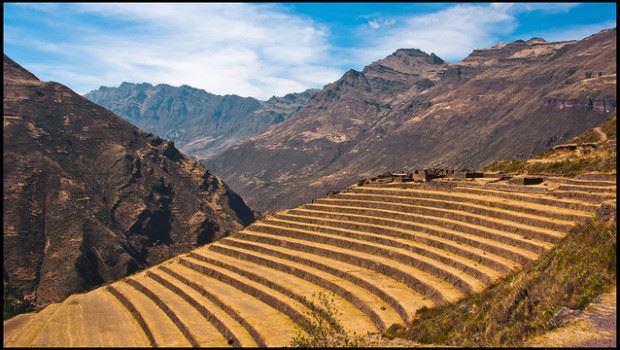Although Machu Picchu is without doubt the biggest attraction in Peru (and South America) the fantastic thing about a visit to the Cusco region is that it is located in a valley which is full to bursting with fascinating and diverse Inca sites.
The Sacred Valley of the Incas, also known as the Urubamba Valley after the river that flows along its base, measures less than 100 miles in length. In spite of its small size it formed the heartland of the Inca Empire and one of its most important maize producing regions. This has endowed it with a concentration of first-class archaeological sites that is unparalleled anywhere in the world.
Over the weeks to come we’ll be looking at some of the most important individual sites, but here is a brief rundown of the most easily-reachable sites in the valley.
Qurikancha
Located in Cusco itself, this was the most important temple in the Inca Empire as it was dedicated to Inti, the sun god. A colonial era church (Santo Domingo) is built on its foundations, and a visit to the complex is a history lesson in and of itself.
Saksaywaman
On the northern outskirts of Cusco, this vast complex is arguably the second most impressive Inca ruin after Machu Picchu. Its huge walls and excellent view of the valley made it an impregnable fortress, but Saksaywaman was also used for religious rituals. It is probably the finest example of Inca stone-masonry.
Section Type: standardWidthImageS
The stone masonry at Saksaywaman (Picture: Andrew Carman)

Pisac
The picturesque Andean village of Pisac, at the base of the ruins of the same name, is one of the most popular destinations in the valley not least for its enormous market which is officially open on Tuesdays, Thursdays and Sundays when the town turns into a bit of a circus. If you come on another day you’ll still see plenty of market, and you’ll also get a chance to witness the incredible terrace fields below the ruins in relative peace.
Moray
Section Type: imageOnLeftParagraphToRight
Probably the most striking example of ‘extreme Inca landscaping’, Moray features concentric terraces which form enormous bowl-like depressions. The temperature inversion caused by the design means that there can be a difference of as much as 27°F between the top and bottom terraces – something which has fueled the theory that Moray was used as an agricultural research station by the Incas.

Salinas de Maras
Located just a few miles from Moray, the salt pans near the town of Maras are another example of intricate Inca landscaping. Fed by a salt-rich spring, water flows through myriad channels and evaporation ponds before salt is harvested in the centuries-old traditional manner. What sets the salt mines apart is that they are still functional, making them an incredibly interesting place to visit.
Ollantaytambo
Ollantaytambo may be the last station on the Machu Picchu line, but it’s also got a lot to offer in its own right. It is one of a handful of towns that retains its original Inca walls and street grid, and its residents go about their business in much the same way that they have for centuries. Above the town a set of terraces looms – these were used by Inca archers in their most important victory over the Spanish.
Section Type: standardWidthImageS

If you’ve been to all of these places and still want more, fear not. The Sacred Valley has loads more up its voluminous sleeves, not least the incredible Choquequairo ruins which can only be reached by foot.
Section Type: cta
Keen to see the Sacred Valley for yourself? Check out our Machu Picchu & Peru itineraries or speak to one of our Destination Experts about crafting the bespoke vacation of your dreams.

 South America
South America South America
South America